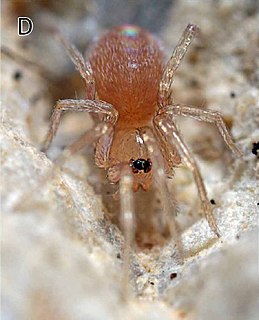
Anyphaenidae is a family of araneomorph spiders, sometimes called anyphaenid sac spiders. They are distinguished from the sac spiders of the family Clubionidae and other spiders by having the abdominal spiracle placed one third to one half of the way anterior to the spinnerets toward the epigastric furrow on the underside of the abdomen. In most spiders the spiracle is just anterior to the spinnerets. Like clubionids, anyphaenids have eight eyes arranged in two rows, conical anterior spinnerets and are wandering predators that build silken retreats, or sacs, usually on plant terminals, between leaves, under bark or under rocks. There are more than 500 species in over 50 genera worldwide.

Oonopidae, also known as goblin spiders, is a family of spiders consisting of over 1,600 described species in about 113 genera worldwide, with total species diversity estimated at 2000 to 2500 species. The type genus of the family is OonopsKeyserling, 1835.

Wandering spiders (Ctenidae) are a family of spiders that includes the Brazilian wandering spiders. These spiders have a distinctive longitudinal groove on the top-rear of their oval carapace similar to those of the Amaurobiidae. They are highly defensive and venomous nocturnal hunters. Despite their notoriety for being dangerous, only a few members of Phoneutria have venom known to be hazardous to humans, but the venoms of this family are poorly known, so all larger ctenids should be treated with caution.

Glenognatha is a genus of long-jawed orb-weavers that was first described by Eugène Louis Simon in 1887. It was considerably revised in 2016.
Anyphaenoides is a genus of anyphaenid sac spiders first described by Lucien Berland in 1913. It is a senior synonym of "Quechuella"

Eustala is a genus of orb-weaver spiders first described by Eugène Simon in 1895.

Ocrepeira is a genus of orb-weaver spiders first described by George Marx in 1883.
Otiothops is a genus of palp-footed spiders that was first described by W. S. MacLeay in 1839.
Metagonia is a genus of cellar spiders that was first described by Eugène Louis Simon in 1893.

Xenoctenidae is a family of araneomorph spiders separated from Miturgidae in 2017.

Alpaida is a genus of South American orb-weaver spiders first described by Octavius Pickard-Cambridge in 1889.







